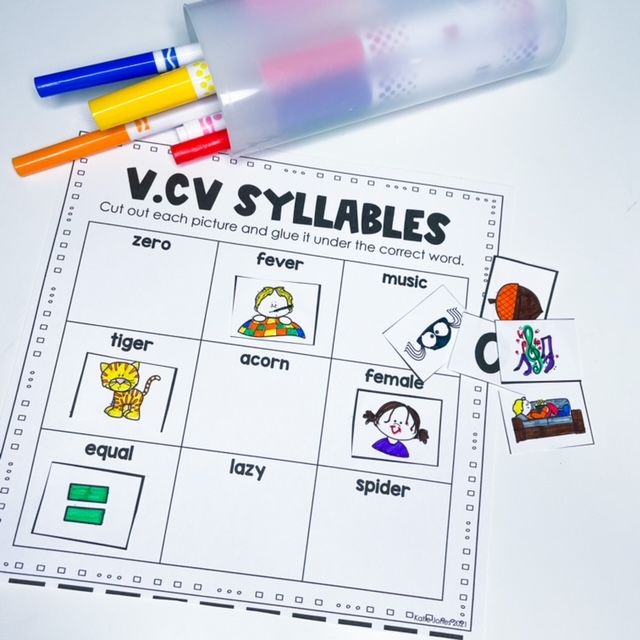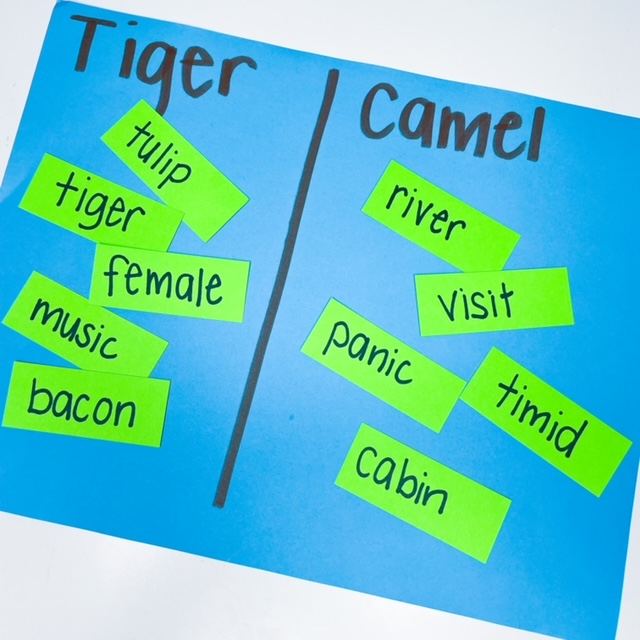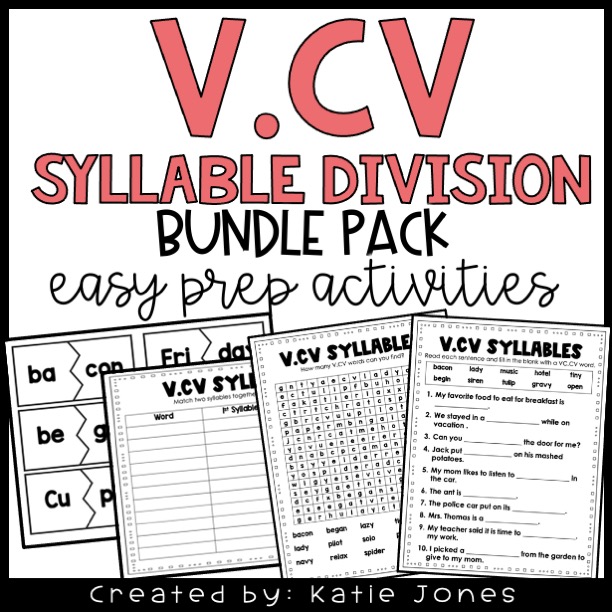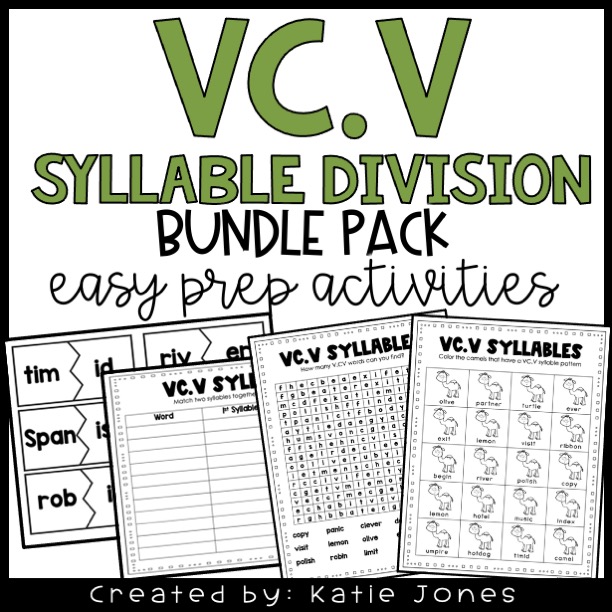The VCV (vowel-consonant-vowel) syllable division can be tricky for students because at times the syllable division occurs after the vowel, making the vowel long, and other times the syllable division occurs after the consonant, making the vowel short.
As previously discussed, each syllable division has been given an animal name. These animal names were provided during a 60 hour Orton Gillingham training I attended. The animal names help students remember the pattern, as each animal name follows the rule.
When the syllable division occurs after the vowel, we call it a Tiger word. The word tiger is an example of a V/CV, because we divide the word after the ‘i’ to create two syllables: ti/ger.

When the syllable division occurs after the consonant, we call it a Camel word. The word camel is an example of a VC/V, because we divide the word after the ‘m’ to create two syllables: cam/el.

Step 1:
Instruction of all syllable divisions needs to start with a review of vowels and consonants. Students should have a firm grasp on the difference between short vowels and long vowels.
Step 2:
Next, I have students practice counting syllables. This can be done in different ways:
- Students can use their fingers to count out the syllables.
- Students can feel under their chin as they say a word. As they say the word, they can hear the different syllables. (I have found this method to be more difficult for many students.)
- Students can clap out the syllables.
- Students can use a manipulative, such as a fidget popper, to pop each sound. (This is my favorite manipulative to use. You can find it on Amazon HERE.

I also suggest reviewing open and closed syllables. Understanding these two syllable types will help students more easily identify and utilize this syllable division.
Step 3:
After students have shown mastery of vowels, consonants, and counting syllables, you can move on to explicitly teaching them the syllable division. Explicit instruction is a crucial step for all students, but 100% necessary for dyslexic learners. Understanding syllable division rules will help students read and spell unknown words.
TIGER RULE: When there is a consonant between two vowels, divide the word after the first vowel creating an open syllable at the beginning.

CAMEL RULE: When there is a consonant between two vowels, divide the word after the consonant creating a closed syllable at the beginning.

I know what you’re thinking: “both of these rules have the same pattern, how do students know which rule to follow?” The TIGER rule is more common. Over 75% of the time when a word has a VCV pattern, the word will be divided after the vowel.
You can help students remember this by asking “If a camel and a tiger got into a fight, which animal would probably win?” The student would quickly say “tiger!” At this point, I remind students that the tiger rule is more common. I then ask: “is there a chance a camel might win?” There is always a chance, which means it is possible for the camel rule to take over.
I instruct students to always try the tiger rule first when trying to decode a new word. If they read the word and it doesn’t make sense, then they can try the camel word.
Example: When given the word “river,” a student should first divide the word into syllables after the “i” and read ri/ver. After reading this the student should recognize this isn’t a word they know and should then try the camel rule by dividing after the ‘v.’ This would prompt them to read the word correctly.
Step 3:
I like to have students label the consonants and vowels in each word before attempting to read it.

After labeling, I’ll have students put a dot after the first vowel to represent the syllable division. During my Orton Gillingham training it was suggested to use a dot instead of a line. Depending on the word and the line the student draws, the line can end up looking like the letter “l.” This can be problematic when students are trying to blend the syllables.
Students will then draw a scoop to show each syllable. From here, students can blend each individual syllable and then blend the two syllables together to form a word.
If they don’t recognize the word they read, the student should rewrite the word, label it, and put a dot after the consonant. The student can then draw a scoop to indicate the two syllables and read the word.

Step 5:
Students can then practice reading a variety of words on their own that follow each rule. I would suggest having students practice each word in isolation first, and then mix the words up to allow students to determine which rule to use.
—> Here are ten tiger words you can use for practice:
label
relax
silent
open
music
tulip
super
siren
paper
spider
—> Here are ten camel words you can use for practice:
panic
polish
visit
timid
robin
clever
denim
finish
habit
lemon
Step 6:
After students have shown success with reading, it is important to practice spelling. Anytime you are teaching a skill in reading, it should always be taught and practiced with spelling. It is important for students to see the connection between reading and spelling.
Remind students to listen to the first syllable and determine if it is open or closed. This will help them as they begin to spell the word.
Step 7:
After explicit instruction and guided practice, students can begin practicing the skill independently through a variety of activities.
Students can color and cut various pictures and glue them under the correct word. This would require students to correctly divide the word into two syllables and read accurately.

On this worksheet students will be able to practice spelling words. I like to encourage students to go back and label their vowels and consonants after spelling. I then will ask them to show the division and swoops. This helps students get in the habit of being their own spell checker.

You could also have students play games for extra practice during center activities. One of the easiest games to play is a syllable matching game. Students have to match two syllables together to form either a tiger or camel word. You can grab my pre-made game (just cut and go) for tiger words HERE and camel words HERE. Each game is only $1. You can also write the words on index cards and cut between the syllables or have the students do this to create their own game!
Students can also sort words into two categories: tiger words and camel words.

The most important thing to remember is explicit instruction needs to occur before practice. You can grab my entire bundle of tiger word practice by clicking HERE.
The bundle of camel word practice can be found by clicking HERE.
There are 5 other syllable division types that can and should be taught after VCCV rabbit. Head to my 6 Syllable Divisions Students Should Know post to learn more about the other types. You can also grab my complete pack of syllable division posters by clicking HERE.



